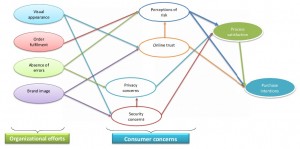Importance of consumer concerns
To create and sustain long-term and mutually beneficial online and offline relationships organizations need to reduce consumers’ perceived risk; increase consumer trust and lessen security and privacy concerns. Addressing these consumer concerns is highly important because consumers increasingly rely on internet for their regular information search and purchase. The recent cyber-attacks on many high profile corporations’ websites and privacy breach has made these consumers concerns even more prominent because within online context the face to face interaction is absent, behavioral intentions of the firm collecting personal data is not clear and in many cases information is often collected without express consent of the consumer.
To alleviate these concerns relating to risk, trust, security and privacy, organizations need a deeper understanding of how their organizational efforts affect consumer concerns in an online context. To reduce these concerns and increase consumer engagement, organizations often attempt various tactics. For example, many focus on building a more visually appealing website and also attempt to reduce errors in terms of information accuracy and website navigation. Additionally, extant research suggests that brand image of an organization and the order management process can also influence consumer perceptions positively. Based on the above I conducted a study particularly focusing on four important organizational effort components namely:
- visual appearance of a web-site
- order fulfillment process
- absence of errors and
- brand image.
The study developed and empirically examined an integrative framework by asking following research questions:
- What organizational efforts influence consumer concerns in online context and to what extent?
- What is the inter-relationship between the consumer concerns variables? And
- How consumer concern variables affect process satisfaction and purchase intentions?
Rather than going into the modelling and other such scientific issues I shall now discuss what was found. If you want to read the full paper, you can get it at the reference given below.
The framework below shows what was found and the explanation about each of the relationships and as a manager how can you act on it is explained below.
Effect of organizational efforts on consumer concerns
What should you do about the look and feel of your website?
One of the important contributions of this study pertains to the direct effects of organizational efforts on consumer concerns. This research shows that the effects of the visual appearance of websites are significant in influencing online trust and security concerns. The results show that website appearance increases trust and at the same time reduces security concerns. The finding highlight the importance of building a visually appealing website which is professional looking and displays high level of artistic sophistication and creativity. A site which is visually more welcoming will in turn reduce consumer security concerns and increase online trust.
What role does order fulfilment play in consumer decision making?
There is a positive relationship between order fulfilment and perceptions of risk. This is a surprising result as it was posited that offering clarity regarding order fulfilment process will reduce the perceptions of risk. This could be a result of the ownership delay occurring between the time an order is placed and the time the goods are delivered. It seems that consumer perceptions of risk remain high in online purchase context because the possession utility is not satisfied immediately compared to offline environment. The extant literature suggests that demonstration of various tools such as secure payments and associated costs should reduce the overall consumer anxiety and in turn reduce consumers’ perceptions of risk. However, the results of this study offer contradictory findings. The results indicate that consumers remain anxious till the physical delivery of the product is not accomplished.
What is the effect of missing and wrongly linked pages on my website?
The importance of relevant and clear linkages within a website is highlighted by the relationship between absence of errors and perceptions of risk as well as privacy concerns. The higher the number of errors on a website, the higher the risk consumers felt and the higher their privacy concerns. The finding further corroborates with earlier discussion on visual appearance. An organization should continuously strive to build a visually appealing, creative and professional looking website and at the same time should make sure that it is free of errors. Managing the visual appearance and absence of errors simultaneously will result in reduction in perceptions or risk, security and privacy concerns and more importantly increased online trust.
What about the role of brand image?
The effect of brand image on consumer concerns is also important because it helps explain a consumer’s association with a brand in an online context. The model shows that although investment in building a better brand image increases online trust, it does not lessen consumer security concerns. The finding corroborates with earlier research that brand image helps increase online trust. However, offers a contradictory result with regards to security concerns, the results indicate that consumer’s generic scepticism of online platforms is a much deeper phenomenon and brand components may not be able to lessen that concern.
Interaction among consumer concern variables
What is the relationship between security and privacy concerns and can trust reduce risk perceptions?
Another major contribution of this study is the empirical demonstration of interaction among consumer concern variables. The interrelationships show that security concerns affect privacy concerns. This offers empirical support to the arguments put forward in extant literature. The results show that the influence of online trust on perceived risk is also worthy of attention. If an organization can increase trust in their online engagement with consumers, the risk the consumer perceives will reduce. This means the consumer will have a higher tendency to purchase from that specific organization. In this regard, the visual appearance and brand image component also become critically important as they are shown to have a significant influence on increasing online trust.
What can managers do about consumer concerns?
For online retailers, shopping basket abandonment is a critical problem. Recent Forrester research indicates that 88% of consumers have abandoned an online shopping basket. It is not difficult to imagine situations wherein consumer concerns may increase due to visually non-appealing website, multitudes of errors, unclear order management process and lack of investment in building a brand image online. This will have a direct influence on process satisfaction resulting in consumer shopping cart abandonment. The findings of this study offer an avenue for managers to increase consumer process satisfaction and purchase intentions by demonstrating how their own efforts can increase or lessen consumer concerns. The findings highlight the complex web of decision cues consumers consider before purchase. Moreover, the study findings will help managers direct their efforts to enhance consumer experiences and lessen the shopping cart abandonment.
The results suggest that if a firm clearly communicates the actions it takes with regards to security of its online platform, consumers may have lower privacy concerns and therefore may be willing to provide more personal information. This may help the firm in its relationship marketing campaign significantly. This is especially important in the context of recent cyber-attacks on major corporations where personal data of millions of consumers were compromised.
There is ample research which shows that risk perceptions are an impediment to the growth of e-commerce. As such it is crucial for online marketers to reduce the perceptions of risk. The study findings provide a way forward for managers in this regard. For example, the findings show that if an organization focuses its efforts on engaging visual appearance and builds a better brand image, it can increase online trust. This in turn will reduce perceived risk and increase process satisfaction. The higher online trust and process satisfaction will increase purchase intentions significantly. Managers should also focus their efforts on reducing errors on their online platform and provide clear information regarding consumer’s orders. This will also reduce perceptions of risk and in turn will increase purchase intentions. The results demonstrate the other important aspect relating to absence of errors as it reduces privacy concerns. Privacy concerns in turn increase the process satisfaction and therefore increase the likelihood of purchase. While the visual appearance of a website do not directly affect consumer perceptions of risk, the results show that visual appearance affect online trust and security concerns. Both these concerns are critical for increasing process satisfaction and purchase intentions. Thus, investment in visual appearance should be directed towards building trust and lessening security concerns.
Shukla, Paurav (2014), “The impact of organizational efforts on consumer concerns in an online context,” Information and Management, 51 (1), 113-119. http://dx.doi.org/10.1016/j.im.2013.11.003








